This no-knead bread recipe will make any novice baker look like a pro! 5 minutes of work yield a crusty, golden loaf with a perfect soft interior.

If you’re curious about bread-making, no-knead bread is a fantastic place to start. This method was made famous by Jim Lahey, owner of Sullivan Street Bakery in New York. It’s wildly popular, and for good reason. Unlike many bread recipes, it requires no special equipment (aside from a Dutch oven) or finicky ingredients, and it takes just a few minutes of hands-on prep. Still, thanks to a long, slow rise, the bread comes out perfect every time, with a gorgeous golden brown crust and chewy interior.
I make a few tweaks to Jim’s recipe, swapping bread flour for all-purpose and amping up the flavor with lemon zest and rosemary. It’s bright, aromatic, and soft, the perfect accompaniment to a hot bowl of soup or a delicious snack all on its own. Next time you’re in the mood for bakery-quality bread, skip a trip to the store, and bake this bread instead. It’ll be more fun, less expensive, and just as good (if not better). Trust me, this classic recipe isn’t one you want to miss.
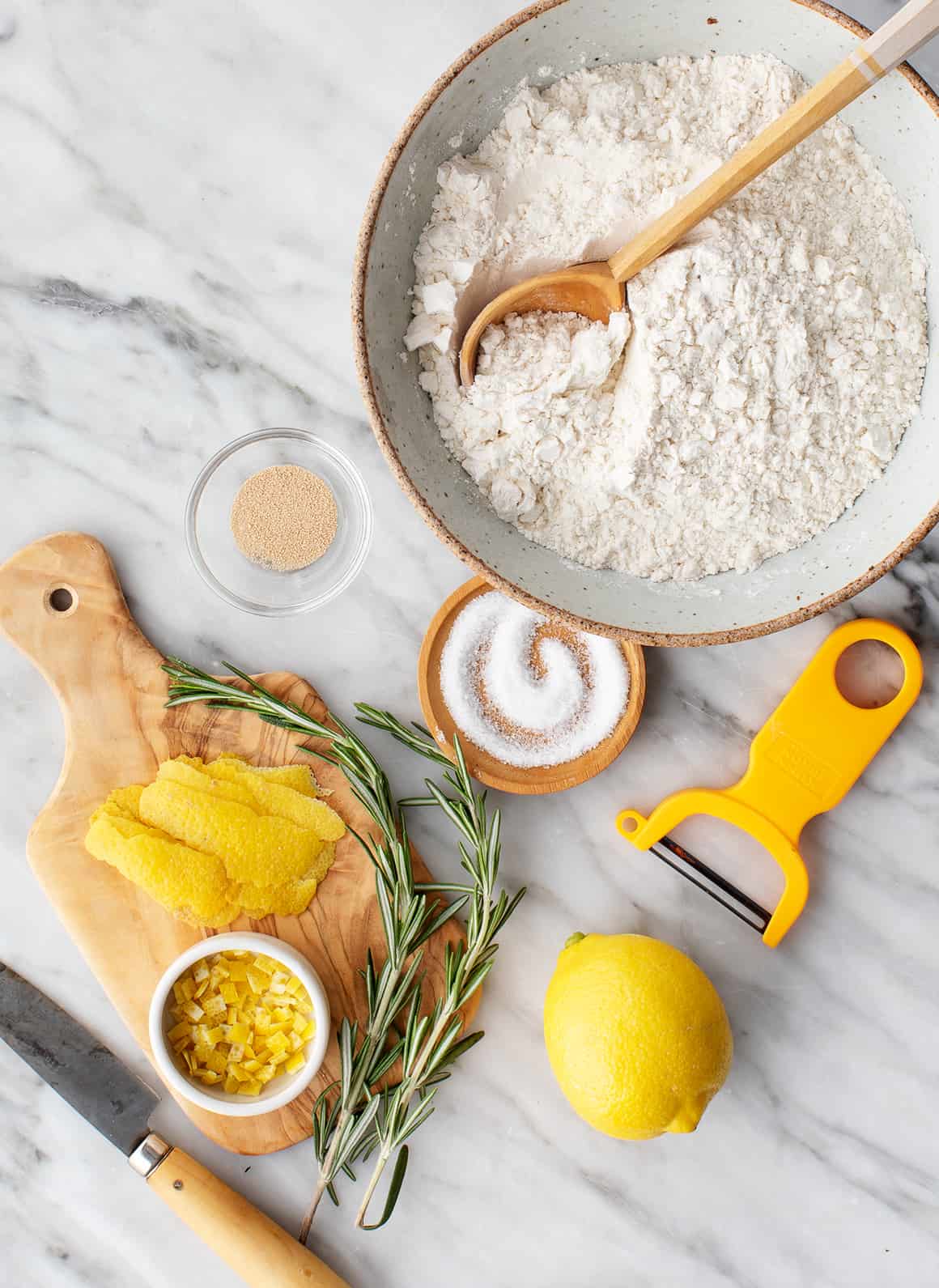
No-Knead Bread Recipe Ingredients
You only need 6 basic ingredients to make a mind-blowing loaf of no-knead bread:
- Flour – Jim Lahey’s original recipe calls for all-purpose flour, and if it’s what you keep on hand, it will work in this recipe. However, Jack and I prefer to make this recipe with bread flour. The bread comes out slightly less dense, with a lighter, chewier texture that we can’t get enough of.
- Active dry yeast – This no-knead bread couldn’t rise without it!
- Lemon zest – I typically grate lemon zest when I’m cooking, but for this recipe, I dice it into small squares for a more intense lemon flavor. The whole loaf is lemony, but the bites with zest are extra-bright and fresh.
- Fresh rosemary – Its cozy flavor makes this loaf comforting and homey. Fresh thyme would be lovely here as well.
- Sea salt – It makes the bright, aromatic flavor of the lemon and rosemary pop.
Just add water, and you’re good to go!
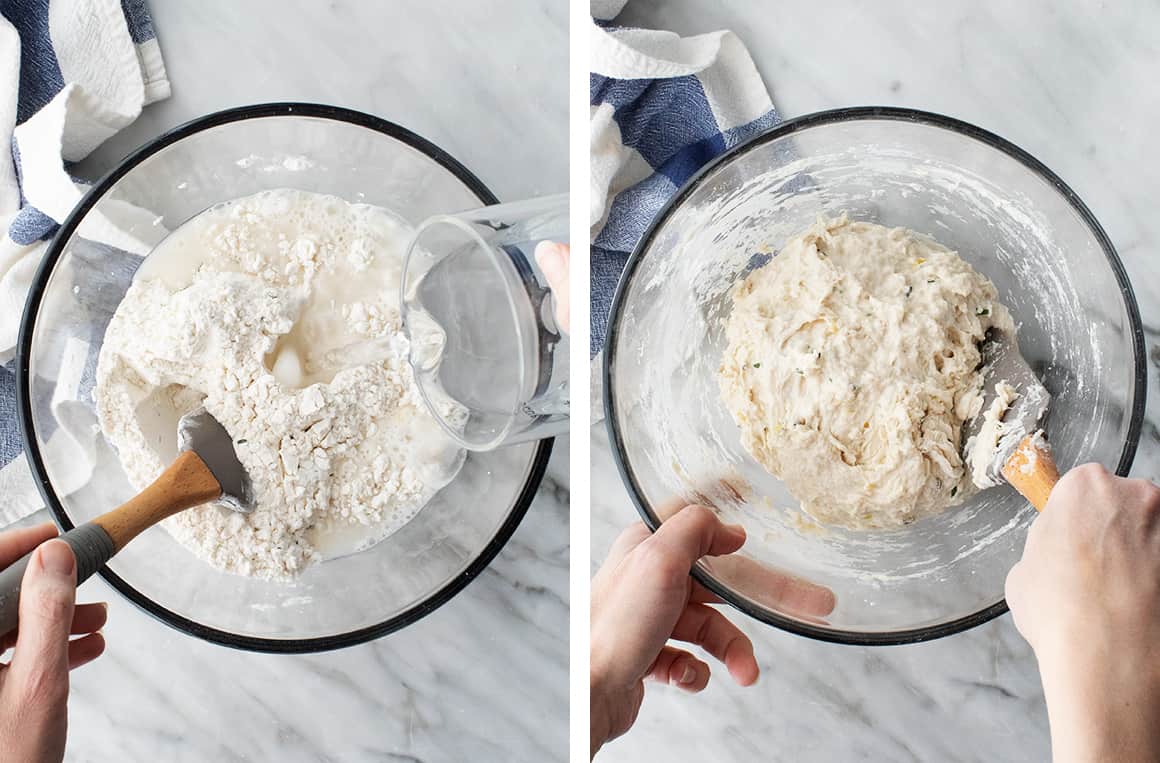
How to Make No-Knead Bread
It’d be impossible to find an easier, more reliable bread recipe than this one. Here’s how you make it:
First, combine the flour, yeast, salt, lemon zest, and rosemary in a large bowl. Then, add the water and stir to form a very sticky dough. Cover the bowl with plastic wrap, and let the dough rest in a warm spot for 12 to 24 hours, until the surface is dotted with bubbles.
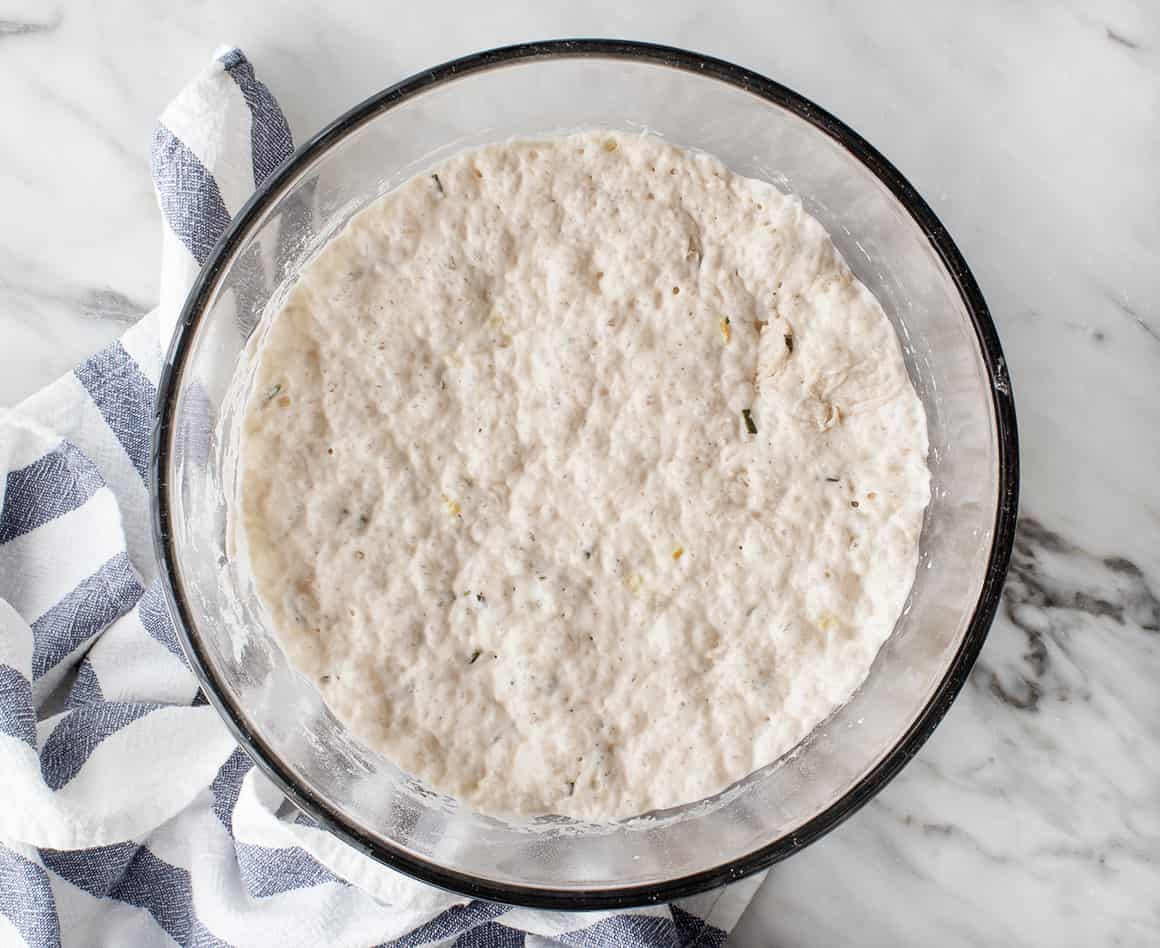
When the dough has risen, turn it out onto a lightly floured work surface. Sprinkle the dough with a little flour and fold it over onto itself once or twice. Cover it loosely and let it rest for 15 minutes.

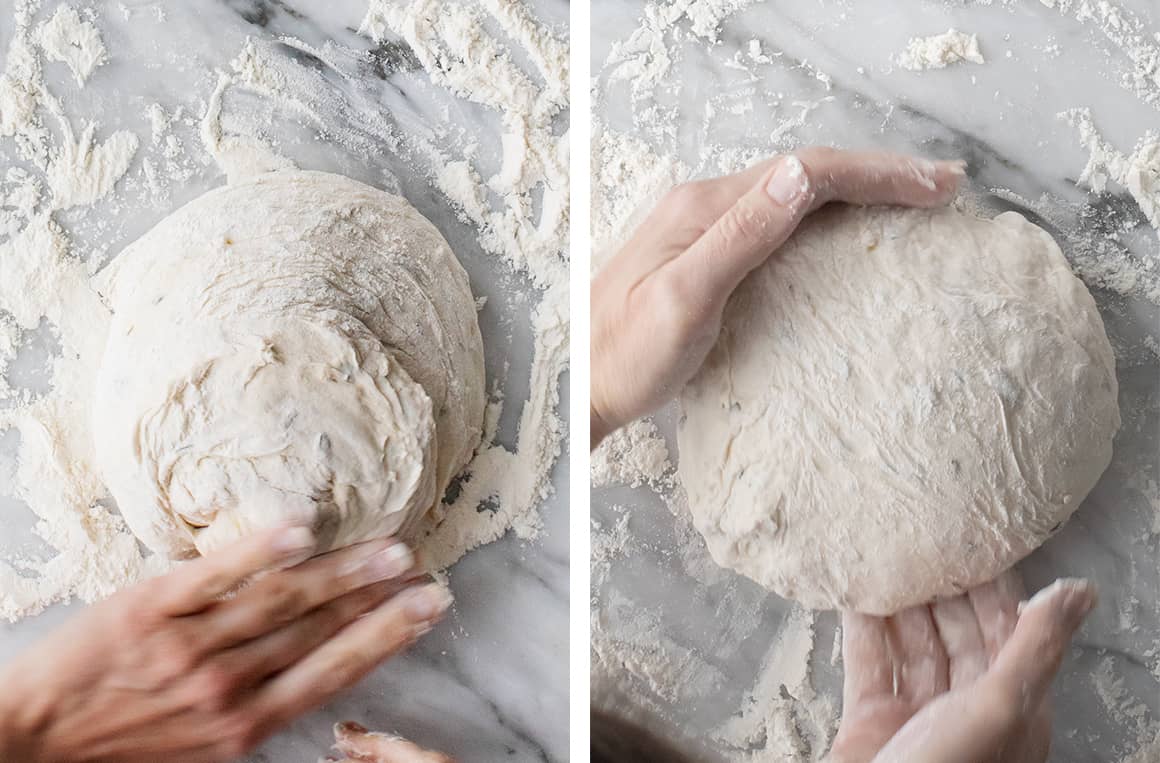
Turn the dough out onto a lightly-floured work surface and quickly shape the dough into a ball.
Then, sprinkle cornmeal onto a flour sack type kitchen towel and place the dough, seam side down, onto the towel. Dust the top of the dough with more cornmeal.
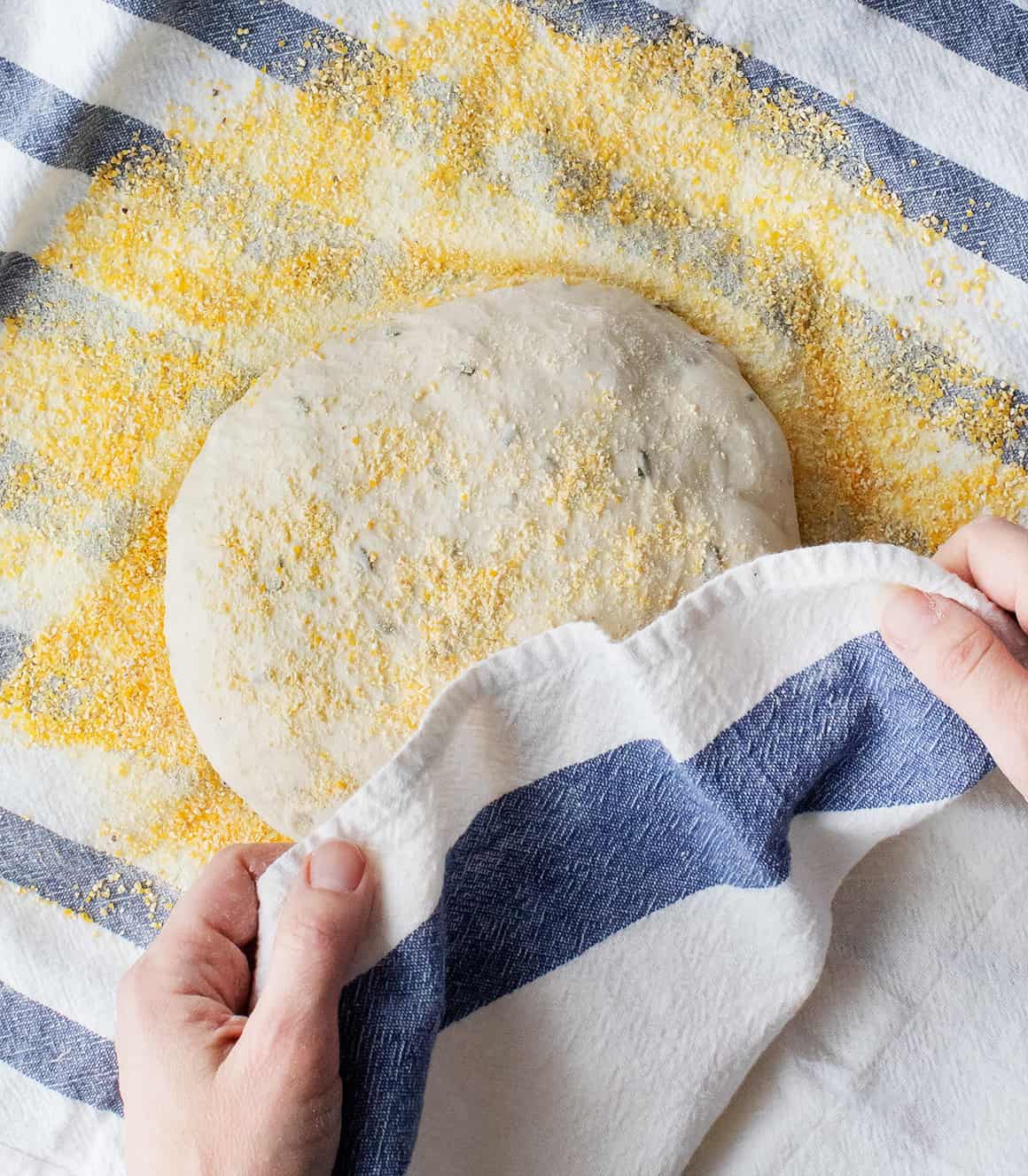
Cover with another towel and let rise until the dough is more than double in size, about 2 hours.
30 minutes before the dough is ready, heat the oven to 450°F and place a 4-quart covered Dutch oven in the oven as it heats.

When the dough has finished rising, carefully remove the pot from the oven (it will be hot!). Turn the dough over, into the pot, so that it’s seam side up. If it looks messy, that’s ok! Use a sharp knife to cut three shallow slits on top of the dough. Then, cover it, transfer it to the oven, and bake for 30 minutes. Remove the lid and bake until the bread is golden brown on top.
Cool on a wire rack for 10 minutes before turning out the bread. Slice, and enjoy!
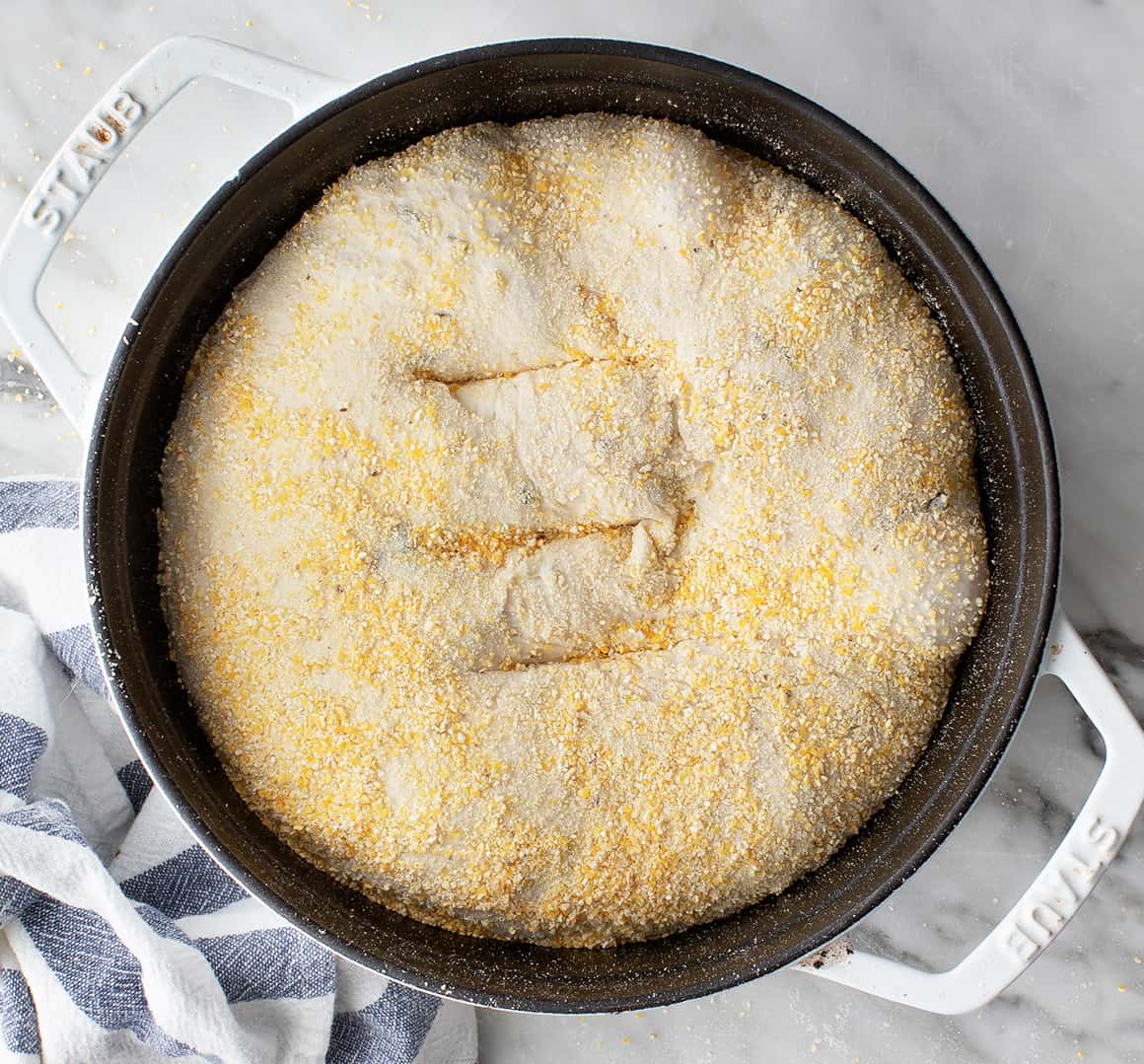
No-Knead Bread Recipe Tips
- Let the dough rise somewhere warm. Because yeast responds to warmth, letting your dough rise in a warm place will yield the best results. We like to put ours on a sunny windowsill!
- Time the first rise based on your schedule. This bread turns out well after an initial rise of anywhere from 12-24 hours. That’s a big range! You might notice slight differences in the final loaf depending on how long the rise is (it’ll be puffier the longer it goes), but really, this range is just to give you flexibility. As long as the dough is dotted with bubbles when you move on to the next step, let it rise for as long as is convenient for you.
- Be gentle. When no-knead bread comes out well, it’s dotted with air bubbles, and it has a light, soft texture. To achieve this, be gentle with the dough. After the initial rise, turn the dough out of the bowl carefully, taking care to preserve as much volume as you can while you work with it. Whatever you do, don’t punch it down!
- Not sure if your dough is ready to bake? Poke it! To make sure your dough is ready to bake after its 2 hour rise, poke it with your finger. If it springs back right away, let it rise a bit longer. It’s ready to bake when it slowly bounces back.
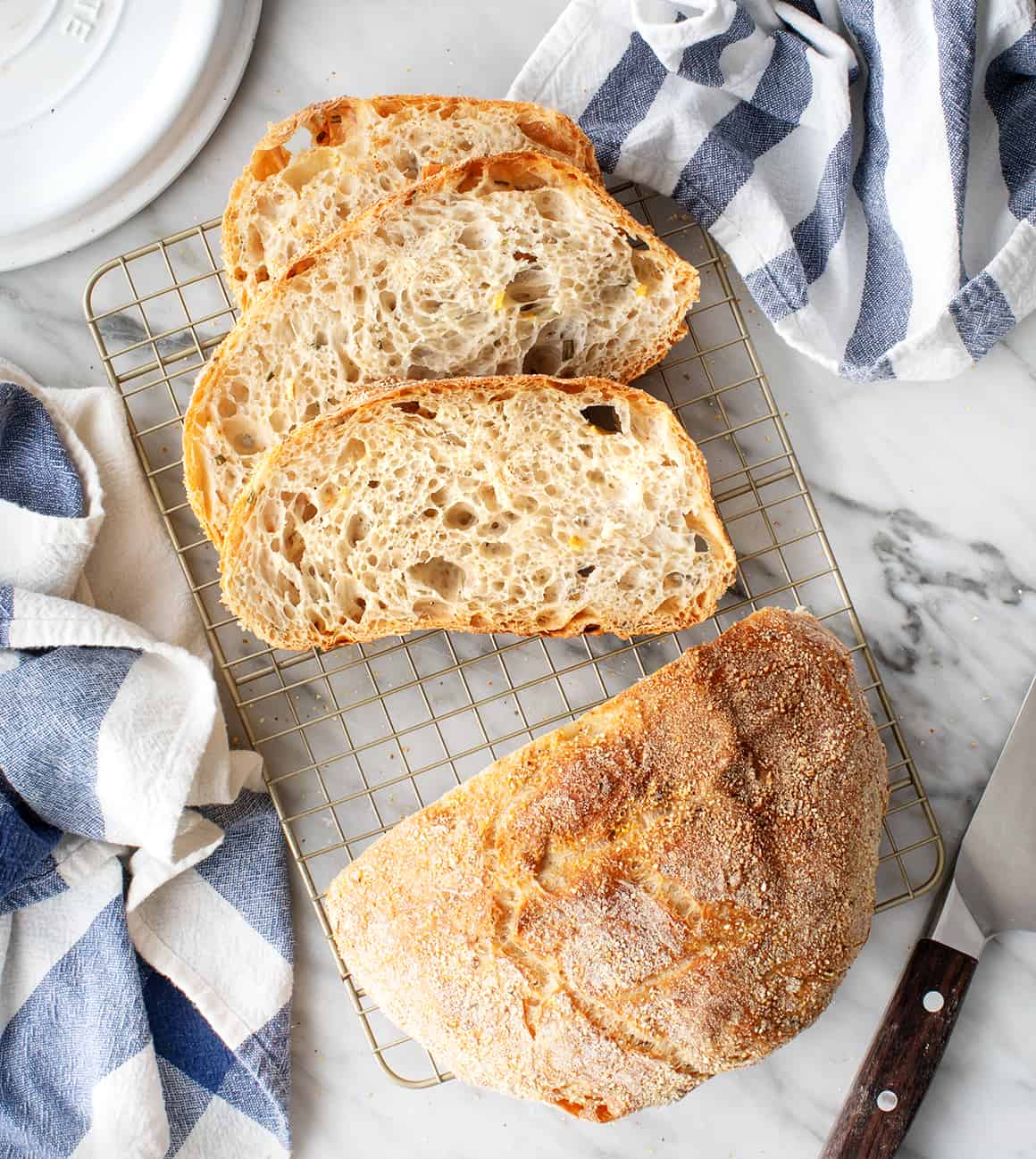
Serving Suggestions
Crusty and flavorful, this no-knead bread is delicious on its own with a pat of butter or drizzle of olive oil. Enjoy it as a snack or light breakfast, or pair it with any soup, salad, or pasta recipe.
We like to eat it fresh the first day with whatever we’re having for dinner. Then, I slice and freeze whatever’s left. Later, I pop frozen slices directly in the toaster to make avocado toast or to serve with a larger meal. If you don’t want to freeze your bread, store it in an airtight container at room temperature for up to two days.

If you love this no-knead bread recipe, try our homemade focaccia next!

No-Knead Bread
Ingredients
- 3 cups bread flour
- 1/4 teaspoon active dry yeast
- 1 1/2 teaspoons sea salt
- 1 tablespoon diced lemon peel
- 1 tablespoon minced rosemary
- 1 1/2 cups water
- 1/4 to 1/3 cup Cornmeal
Instructions
- In a large bowl, combine the flour, yeast, salt, lemon, and rosemary. Add the water and stir until blended. It will be very sticky. Cover the bowl with plastic wrap and let rest in a warm spot (75° is ideal) for 12 to 24 hours, until the surface is dotted with bubbles.
- Place the dough on a lightly floured surface then sprinkle with a bit more flour. Turn the dough over onto itself once or twice. The dough will be very wet and sticky - that's ok - just don't knead the dough. Cover loosely and let rest for 15 minutes.
- Turn the dough out onto a lightly-floured work surface. Lightly flour your hands and gently shape the dough into a ball without kneading it. Sprinkle cornmeal onto a flour sack type kitchen towel and place the dough, seam side down, onto the towel. Dust the top of the dough with more cornmeal. Cover with another towel and let rise until the dough is more than double in size, about 2 hours.
- 30 minutes before the dough is ready, heat the oven to 450°F and place a 4-quart covered Dutch oven in the oven as it heats.
- Use oven mitts to carefully remove the pot from the oven. Turn the dough over into the pot so that it’s seam-side up. If necessary, shake the pan a bit to evenly distribute the dough. Use a sharp knife to cut three shallow slits on top of the dough. Cover and bake for 30 minutes, then uncover and bake 15 to 30 minutes more, until golden brown on top.
- Cool on a wire rack for 10 minutes before removing from the pot.
Adapted from Jim Lahey’s no-knead bread recipe, via Mark Bittman and the New York Times.








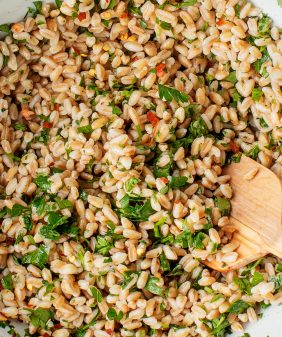





jeanine:
this is a brilliant take on jim lahey’s bread.
rosemary and lemon. my two favorites. i am munching right now. thank you!
Hi!!!
I just wanted to know if Polenta would work as a substitute to cornflour?
Thank you
hmm… I think that would be fine, or even a light dusting of flour – it’s main purpose is so that it doesn’t stick to the Dutch oven. If you used parchment paper to line, you could skip it altogether.
for the whole wheat Focaccia recipe…what do you do if the dough is dry and not wet?
what is the best method to form the dough into a nice ball shape?
thanks!
Hi Miriam, did you use these amounts of white and wheat flour? It would be too dry with all wheat flour.
3½ cups all-purpose flour, plus more for kneading
1½ cups whole wheat flour
Since it sounds like you’re already into it, I would try kneading more water into the dough until it comes together as a ball.
this is an amazing bread…but would luv to know how to do it with whole wheat…can it be done with whole wheat or spelt flour?
Hi Miriam, I’d follow the ratios in this recipe: https://leitesculinaria.com/21678/recipes-no-knead-whole-wheat-bread.html
Disappointing to read at the beginning that it needs no special equipment and then to get to later in the post and find out it needs a Dutch oven…
Does it have to be a 4 quart dutch oven or can it be a bigger size? I’m having a tough time finding a 4 quart.
Hi Morgan, it can be bigger, it’ll just be a flatter loaf. It should still be tasty though!
You just say “water” .
It needs to be warm water right??? Total newbie over here.
Hi Serra, it doesn’t need to be warm. A room-temp-like temperature that comes out of the faucet is fine.
Came out great and so fun to do with my little one! Thanks for the recipe.
I’m so glad you both loved it!
Loving your site so much. the pics are great and all the recipes I have tried so far have been brilliant!
Thanks Jenna!
Hi, looks delicious! How essential is the cornflour component? I am currently on lock down, so wanted to try this but do not have that on me :/
Hi Zuz, it mainly keeps the sticky dough from sticking to the Dutch oven – I think you could probably use parchment paper and skip the cornmeal.
When you say, “quickly make dough into a ball” I had to add some flour to make that happen as the dough was wet and sticky. Is this okay? Also, I used a terra cotta bowl with lid and it was much flatter than I had hoped for avocado toast, but quite tasty.
Hi Ann, it’s normal for it to be very wet and sticky (unlike regular dough) and the results are best when minimal flour is added. I’d say just enough so that it’s not sticking to your hands. It also shouldn’t be kneaded too much because the air bubbles that have formed over the long rise will help it rise while baking. The height probably also has to do with the size of your vessel. The dough fits snuggly into my Dutch oven and the sides of it help it rise while baking. I’m glad it was tasty!
Waiting the 10 minutes is next to impossible as this bread smells so good. It is delicious!! My dutch oven pots are bigger than written in recipe. My loaves turned out flatter than I’d have liked. I’ll make it again!
Its nice recipe it looks yumm..
Great recipe loved by all, so simple to make and tasty.
Do you think this method would work with gluten free flour? One that includes xanthan gum?
Hi Michele, I would do a search for GF bread – it’d be better to start with a recipe that’s tested to be gluten free.
This looks delicious! I have a Corning “Vision” glass Dutch oven. Will the loaf over bake if I bake the bread in glass? If I use a cast iron Dutch oven will I possibly have the same results?
Hi Deborah, without trying, I’m not sure what the results would be. I used a cast iron Dutch oven with a lid.
Is 1/4 tsp yeast correct? Seems far too little
yep, it’s correct. So little is needed because of the long rise time.
Yes, thanks! Had just gone back to original NYT recipe to double check, so here goes!
This looks amazing, but I don’t own a Dutch oven. Do you know how crucial it is or would glass pan or cake pan do the same? They won’t warm up the same way but I wonder if that still works.
I think it’s pretty crucial – yes, it’s heat gets hotter than a regular pan… it also bakes covered with it’s heavy lid, which I think is important. But I haven’t tried it another way, so I’m not sure what the difference would be.
How lovely! I’ve always stayed away from bread making because of all the kneading and rising – this sounds perfect!
Can this be made gluten free?
Hi Susan, not this specific recipe – I recommend searching specifically for a Gluten Free bread recipe.